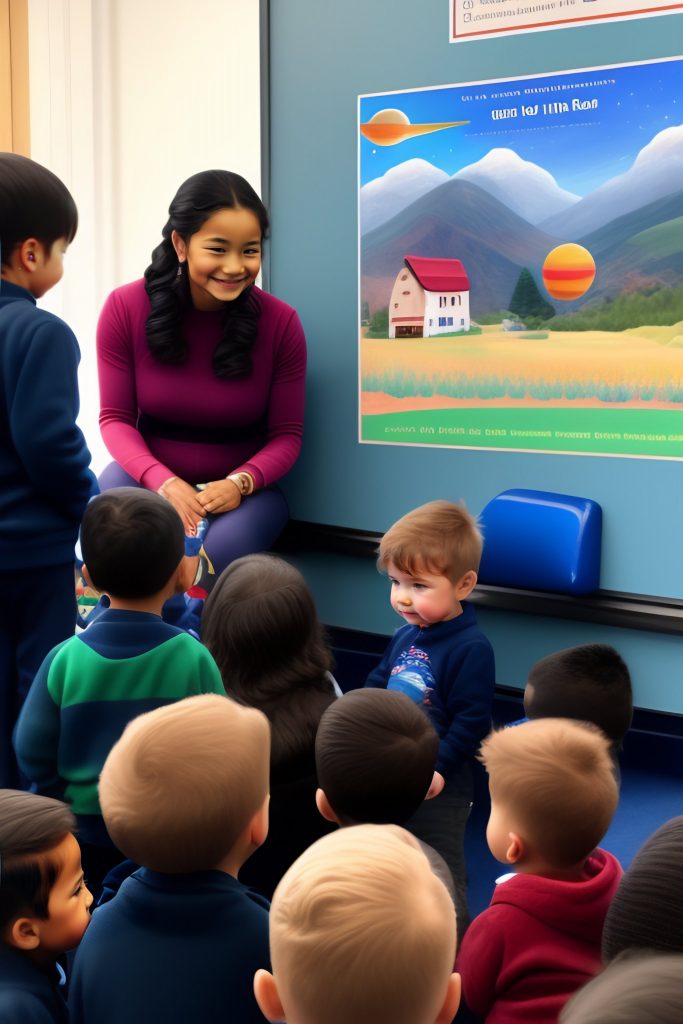
“The Purpose of Life Is Not Only To Be Happy. It is to be Useful, to be Honorable, to be Compassionate, to Make a Positive Difference that we have Lived and Lived Well.”
Empathy, the ability to understand and share the feelings of others, is a vital skill that fosters kindness, connection, and a harmonious society. Nurturing empathy in children is a powerful way to shape their character and equip them with the tools to navigate the complexities of human relationships.
In this article, we present 20 practical and meaningful tips on how to teach and explain empathy to a child, empowering them to become compassionate and empathetic individuals.
Educating Children to the powerful concept of empathy can be a transformative experience, shaping their understanding of compassion and kindness. In a world that often emphasizes individuality, teaching empathy becomes crucial in fostering connections and building harmonious communities.
So, how can we guide young minds to understand and embrace empathy? In this guide, we’ll unlock the secrets to cultivating empathy in children, unveiling practical tips and engaging activities that will empower you to navigate this enriching journey with your little ones.
Get ready to embark on a remarkable adventure where empathy becomes a natural instinct, forging a brighter future filled with understanding and heartfelt connections.
- Be an Empathetic Role Model: Demonstrate empathy in your daily interactions, showing your child what it means to understand and care for others.
Here is an Example :
One sunny afternoon, Emma’s six-year-old son, Alex, came home from school looking upset. Emma, being aware of the importance of empathy, decided to use this opportunity to demonstrate empathy and teach her son about it.
Instead of bombarding Alex with questions, Emma sat down next to him and gently asked, “Hey, Alex, you seem a little down. Is everything okay?” She maintained a calm and compassionate tone, signaling to Alex that she was genuinely interested in his well-being.
Alex sighed and shared that he had an argument with his best friend, Sam, during recess. Emma nodded, acknowledging his feelings, and said, “It sounds like you’re feeling sad and maybe a bit frustrated. Arguments can be tough. How do you think Sam might be feeling right now?”
Alex paused, reflecting on the question. “I think he might be angry at me,” he replied.
Emma nodded again, affirming his response. “That’s a possibility, Alex. It’s important to understand how others might feel, especially when we have conflicts. Empathy helps us put ourselves in their shoes and understand their emotions.”
She then shared a personal experience of a disagreement she had with a friend and how they resolved it by empathizing with each other’s feelings. Emma explained, “By listening and understanding each other’s perspectives, we can find common ground and mend our relationships.”
Inspired by her words, Alex started brainstorming ways to resolve the issue with Sam. Emma encouraged him to consider Sam’s perspective and suggested that they both apologize and share their feelings.
Together, they crafted a heartfelt note expressing empathy and a desire to make things right. Emma explained that by taking this empathetic approach, they were nurturing their friendship and showing Sam that they cared about his feelings too.
As the days passed, Alex practiced empathy by actively listening to Sam’s perspective, understanding his emotions, and working together to find common solutions. Through Emma’s empathetic guidance, Alex not only resolved the conflict but also learned the importance of empathy in maintaining healthy relationships.
In this example, Emma demonstrated how being an empathetic role model can help a child navigate difficult situations with understanding and compassion. By empathizing with Alex’s emotions and guiding him to consider Sam’s feelings, Emma effectively taught him the power of empathy in resolving conflicts and fostering meaningful connections.
2. Teach Emotional Literacy: Help your child identify and express their own emotions, enabling them to better understand and relate to the emotions of others.
Teaching emotional literacy and explaining empathy to a child is an important aspect of their social and emotional development. By cultivating empathy, children can better understand and relate to the feelings of others, fostering healthier relationships and a more compassionate society. Here are some practical tips on how to teach and explain empathy to a child.
Firstly, lead by example. Children learn best by observing and imitating the behavior of the adults around them. Demonstrate empathy in your own interactions with others, such as by actively listening, showing understanding, and offering support. By consistently modeling empathetic behavior, you create a positive environment for your child to learn from.
Secondly, encourage open communication. Create a safe space where your child feels comfortable expressing their emotions and thoughts. Encourage them to talk about how they feel and actively listen without judgment. By validating their emotions, you demonstrate empathy, and this can help them understand the importance of acknowledging and empathizing with others’ feelings.
Thirdly, use storytelling and role-playing. Children often respond well to narratives and imaginative play. Choose age-appropriate books, movies, or even personal anecdotes that highlight empathy and its positive impact. Discuss the characters’ emotions and perspectives, asking questions that encourage your child to consider how they would feel in similar situations. Additionally, engage in role-playing activities where your child can step into someone else’s shoes, helping them gain a deeper understanding of different perspectives.
Fourthly, practice active listening skills. Teach your child the importance of listening attentively to others. Encourage them to maintain eye contact, nod in understanding, and ask relevant questions. This active engagement demonstrates empathy and shows the other person that their feelings and thoughts are valued.
Fifthly, encourage acts of kindness and compassion. Engage your child in acts of service or small gestures that demonstrate empathy. This can include helping a friend, sharing toys, or comforting someone who is upset. Encourage them to reflect on how their actions might have positively affected the other person’s emotions.
Lastly, reinforce empathy as a core value. Consistently discuss and reinforce the importance of empathy in your conversations with your child. Emphasize how empathy helps build strong relationships, resolves conflicts, and promotes understanding. Remind them that everyone experiences a range of emotions, and by showing empathy, they can make a difference in someone’s life.
By incorporating these tips into your parenting or teaching approach, you can effectively teach emotional literacy and help your child develop a strong sense of empathy. Remember, fostering empathy is an ongoing process that requires patience and consistent reinforcement, but the positive impact it can have on your child’s personal and social development is immeasurable.
3. Listen Attentively: Encourage active listening skills by teaching your child to give their full attention when someone is speaking and to respond empathetically.
Teaching children the importance of listening attentively is a crucial step in developing their empathy skills. By actively listening, children can understand and connect with others’ emotions and experiences on a deeper level. Here are some practical tips on how to teach and explain the concept of attentive listening to a child.
First and foremost, lead by example. Show your child what attentive listening looks like by giving them your undivided attention when they speak. Put away distractions such as phones or tablets and maintain eye contact. By modeling this behavior, you demonstrate the value of listening and set a positive example for your child to follow.
Secondly, explain the meaning of attentive listening in simple terms. You can tell your child that listening attentively means giving someone your full focus and paying close attention to what they are saying. Help them understand that it involves not only hearing the words but also trying to understand the emotions and thoughts behind them.
Thirdly, encourage your child to practice active listening skills. Teach them to use verbal and non-verbal cues to show that they are engaged and listening. This can include nodding, maintaining eye contact, and responding appropriately to the speaker. Explain that active listening involves asking questions and reflecting on what the other person is saying to show that their thoughts and feelings are important.
Fourthly, engage your child in activities that promote attentive listening. For example, you can play a game where one person shares a story or an experience, and the other person has to repeat or summarize what they heard. This exercise helps develop listening skills and encourages your child to focus on the speaker’s words and emotions.
Fifthly, emphasize the importance of empathy in listening. Explain to your child that attentive listening allows them to better understand how someone else feels and what they might be going through. Help them realize that by truly listening, they can offer support, show kindness, and build stronger relationships with others.
Lastly, provide positive reinforcement and praise when your child demonstrates attentive listening skills. Recognize and acknowledge their efforts to listen carefully and empathize with others. This encouragement will motivate them to continue practicing and refining their listening skills.
By incorporating these tips into your conversations and activities with your child, you can help them develop attentive listening skills and foster empathy. Remember to be patient and provide consistent guidance, as attentive listening is a skill that requires practice and nurturing. With time, your child will become a more empathetic listener who can truly connect with others on a deeper level.
4. Encourage Perspective-Taking: Prompt your child to imagine how others might feel in different situations, broadening their understanding of different perspectives.
Encouraging perspective-taking is a valuable approach to teaching empathy to children. By helping them understand and consider different viewpoints, children can develop a deeper sense of empathy and appreciation for others’ experiences. Here are some practical tips on how to teach and explain perspective-taking to a child.
Firstly, introduce the concept of perspective. Explain to your child that everyone sees the world differently based on their unique experiences, thoughts, and feelings. Help them understand that perspective-taking involves putting themselves in someone else’s shoes to imagine how they might feel or think in a particular situation.
Secondly, use storytelling and role-playing. Engage your child in stories or scenarios that involve different characters with diverse backgrounds or perspectives. Encourage them to imagine being in those characters’ situations and ask questions that prompt them to consider how they might feel or react. Role-playing activities allow children to actively embody different perspectives, fostering empathy and understanding.
Thirdly, facilitate discussions about diverse perspectives. Encourage your child to express their thoughts and feelings while also listening to others’ viewpoints without judgment. Discuss various topics, such as cultural differences, personal challenges, or social issues, and explore how different perspectives shape individuals’ experiences. Encourage critical thinking and open-mindedness to broaden their understanding.
Fourthly, teach active listening during perspective-taking exercises. Guide your child to listen attentively to others’ perspectives, acknowledging and respecting their opinions. Encourage them to ask questions to gain further insight and show genuine interest in understanding others’ experiences.
Fifthly, encourage empathy journals or reflection exercises. Provide your child with a notebook or journal where they can write or draw about experiences when they were able to understand or relate to someone else’s feelings. Encourage them to reflect on what they learned from those situations and how it made them feel. This practice helps reinforce perspective-taking and empathy as ongoing processes.
Sixthly, highlight similarities and differences. Help your child recognize that even though people may have different perspectives, there are often common emotions and desires that connect us all. Emphasize shared experiences and feelings to promote empathy and unity.
Lastly, lead by example. Show empathy and engage in perspective-taking in your own interactions and discussions. When your child sees you considering different viewpoints and demonstrating empathy, they are more likely to internalize these values and behaviors.
By incorporating these tips into your conversations and activities, you can effectively teach and explain perspective-taking to your child, fostering their empathy skills. Remember that empathy is a lifelong journey, and with consistent practice and reinforcement, your child can develop a deep sense of understanding and compassion for others.
5. Promote Kindness: Instill the value of kindness by encouraging your child to perform acts of kindness toward others, both big and small.
Promoting kindness is a powerful way to teach empathy to children. By encouraging acts of kindness, children can develop a genuine concern for others’ well-being and understand the positive impact their actions can have. Here are some practical tips on how to teach and explain empathy through promoting kindness to a child.
Firstly, lead by example. Show kindness in your everyday interactions and highlight the positive effects it has on others. Whether it’s helping a neighbor, showing gratitude, or offering support to someone in need, let your child witness your acts of kindness and explain why you choose to act this way. By modeling kindness, you demonstrate the importance of empathy and inspire your child to follow suit.
Secondly, discuss the concept of kindness with your child. Explain that kindness means being friendly, considerate, and helpful towards others. Use relatable examples to illustrate acts of kindness, such as sharing toys, comforting a friend, or showing appreciation for someone’s efforts. Help them understand that small gestures of kindness can make a big difference in someone’s day.
Thirdly, encourage your child to actively seek opportunities to be kind. Teach them to be observant and attentive to the needs of others. Prompt them to think about how they can offer support or assistance in various situations. Encourage them to think beyond their immediate circle and consider acts of kindness towards strangers or those less fortunate.
Fourthly, engage in kindness projects or initiatives as a family. Participate in community service activities or volunteer at local organizations together. This hands-on experience allows your child to directly witness the impact of their kindness and empathize with those they are helping. Discuss their experiences afterward, highlighting the emotions they observed and how their actions made a difference.
Fifthly, praise and reinforce acts of kindness. Recognize and appreciate your child’s kind deeds by offering specific and sincere praise. Highlight the positive impact their actions had on others and how their empathy played a role. By reinforcing these behaviors, you encourage your child to continue demonstrating empathy and kindness in their daily lives.
Sixthly, discuss the feelings associated with kindness. Help your child understand the emotions experienced by both the giver and the recipient of kind acts. Encourage them to reflect on how it feels to be kind and how it feels to receive kindness. By recognizing and empathizing with these emotions, your child can develop a deeper understanding of the importance of empathy and kindness.
By incorporating these tips into your parenting or teaching approach, you can effectively teach and explain empathy to your child through promoting kindness. Remember that kindness is a habit that can be nurtured and strengthened over time. Through consistent encouragement and reinforcement, your child can grow into a compassionate individual who makes a positive difference in the lives of others.
6. Foster Empathy Through Literature: Read books with diverse characters and stories that explore different emotions and experiences, sparking conversations about empathy.
Fostering empathy through literature is a wonderful way to teach and explain empathy to children. Books offer engaging stories and diverse perspectives that allow children to step into the shoes of different characters and understand their emotions and experiences. Here are some practical tips on how to use literature to teach empathy to a child.
Firstly, select books that feature relatable characters and explore themes of empathy, compassion, and understanding. Look for stories that depict characters from various backgrounds and cultures, as well as characters facing different challenges. This variety will expose your child to different perspectives and help them develop a broader understanding of the world.
Secondly, read the books together and encourage discussions. As you read, pause at key moments in the story to ask questions that prompt your child to reflect on the characters’ feelings and actions. Ask open-ended questions, such as “How do you think the character felt in this situation?” or “What would you do if you were in their place?” This encourages your child to think critically and empathetically about the characters’ experiences.
Thirdly, encourage your child to make connections between the characters’ experiences and their own lives. Help them find similarities between the characters’ emotions and situations and their own experiences. This personal connection can deepen their empathy and help them relate to the characters on a more meaningful level.
Fourthly, discuss the lessons and messages conveyed in the books. Talk about the importance of empathy, kindness, and understanding in the context of the story. Help your child identify instances where characters demonstrate empathy and discuss the positive outcomes of their actions. Encourage your child to think about how they can apply these lessons to their own lives and interactions with others.
Fifthly, engage in creative activities related to the books. Encourage your child to draw or write about their favorite character, their feelings, or how they would handle certain situations. This allows them to express their empathy and engage with the story on a deeper level.
Lastly, expand beyond fiction and explore non-fiction books or biographies that highlight real-life stories of empathy and compassion. These books can inspire your child by showcasing the impact of empathy in the real world and encouraging them to consider how they can make a difference.
By incorporating these tips into your reading routine, you can effectively use literature to teach and explain empathy to your child. Books serve as powerful tools for fostering empathy, expanding their worldview, and encouraging compassion towards others. Through these experiences, your child can develop a lifelong love for reading and a strong foundation of empathy and understanding.
7. Volunteer Together: Engage in community service activities as a family, exposing your child to different realities and fostering a sense of empathy and compassion.
Volunteering together is a fantastic way to teach and explain empathy to children. By actively engaging in community service and helping others, children can witness firsthand the impact of their actions and develop a sense of empathy and compassion. Here are some practical tips on how to teach empathy through volunteering with your child.
Firstly, choose volunteer opportunities that align with your child’s interests and passions. Look for projects or organizations that resonate with them, such as animal shelters, food banks, or environmental clean-up initiatives. When children feel connected to the cause they are supporting, their empathy and enthusiasm are likely to grow.
Secondly, involve your child in the decision-making process. Discuss the different volunteering options and let them have a say in choosing where they would like to contribute their time and efforts. This empowers them and helps foster a sense of ownership and commitment to the cause.
Thirdly, prepare your child for the volunteering experience. Before you embark on the activity, explain to them why volunteering is important and how it helps those in need. Help them understand that the goal is to make a positive impact and support others. Discuss the potential challenges or emotions they might encounter during the volunteer work, emphasizing the importance of empathy and compassion.
Fourthly, actively engage in the volunteering experience with your child. Work side by side, demonstrating your own empathy and enthusiasm for helping others. Encourage your child to interact with the individuals or communities you are serving, fostering connections and understanding.
Fifthly, debrief and reflect on the experience together. After volunteering, take the time to discuss your child’s observations, feelings, and insights. Ask open-ended questions to prompt them to reflect on the impact of their actions and how it made them feel. This reflection helps reinforce the lessons of empathy and encourages them to think critically about the needs of others.
Sixthly, encourage your child to continue volunteering regularly. Make volunteering a consistent part of your family’s routine or establish a schedule that works for your child. Regular engagement allows your child to develop a sense of responsibility and a deeper understanding of the ongoing needs of others.
Lastly, celebrate and acknowledge your child’s efforts. Recognize and appreciate their commitment to helping others. Express pride in their empathy and compassion, highlighting the positive impact they are making. This positive reinforcement encourages their continued engagement in volunteering and reinforces the value of empathy.
By incorporating these tips into your volunteering endeavors, you can effectively teach and explain empathy to your child. Volunteering together not only benefits the communities you serve but also instills lifelong values of empathy, compassion, and social responsibility in your child.
8. Encourage Empathetic Problem-Solving: Teach your child to find solutions to conflicts and problems that take into account the feelings and needs of others.
Encouraging empathetic problem-solving is a valuable approach to teaching and explaining empathy to children. By helping them understand and address the challenges faced by others, children can develop empathy and compassion while actively seeking solutions. Here are some practical tips on how to teach and explain empathetic problem-solving to a child.
Firstly, foster a safe and supportive environment where your child feels comfortable expressing their thoughts and emotions. Encourage open communication and active listening within the family. This foundation of trust allows your child to develop empathy and effectively engage in problem-solving discussions.
Secondly, teach your child to actively listen and ask questions when someone shares a problem or concern. Encourage them to consider how the other person might be feeling and what they might need. Help them understand that empathetic problem-solving involves understanding the emotions and perspectives of others before jumping to solutions.
Thirdly, encourage your child to put themselves in the other person’s shoes. Prompt them to imagine how they would feel if they were facing the same challenge. This exercise helps develop empathy and encourages them to approach problem-solving with compassion and understanding.
Fourthly, emphasize the importance of brainstorming and exploring multiple solutions. Encourage your child to generate ideas and consider different approaches to address the problem. Teach them to evaluate the potential impact of each solution on the person’s well-being and emotions.
Fifthly, guide your child in selecting the most appropriate solution. Encourage them to consider the other person’s preferences and needs. Help them understand that empathetic problem-solving involves finding a solution that respects the emotions and values of all parties involved.
Sixthly, teach your child the value of collaboration and teamwork in problem-solving. Explain that sometimes solutions are best achieved through working together with others. Encourage them to involve the person facing the challenge in the problem-solving process, seeking their input and perspective.
Seventhly, reinforce the importance of reflecting on the outcomes of the chosen solution. Discuss with your child how their empathetic problem-solving approach made a difference in addressing the challenge. Help them recognize the positive impact their actions had on others, fostering a sense of fulfillment and encouraging future empathetic problem-solving endeavors.
Lastly, celebrate your child’s empathetic problem-solving efforts. Recognize and appreciate their compassion, creativity, and willingness to help others. This positive reinforcement reinforces the value of empathy and encourages them to continue using empathetic problem-solving skills in various situations.
By incorporating these tips into your interactions and problem-solving discussions with your child, you can effectively teach and explain empathy through empathetic problem-solving. These skills will not only benefit their relationships with others but also empower them to become compassionate problem-solvers who actively contribute to making the world a better place.
9. Practice Gratitude: Cultivate a sense of gratitude in your child, helping them appreciate the kindness and support they receive from others.
Practicing gratitude is a wonderful way to teach and explain empathy to children. By cultivating a sense of appreciation for the kindness and generosity of others, children can develop empathy and a deeper understanding of the impact of their actions. Here are some practical tips on how to teach and explain empathy through practicing gratitude with your child.
Firstly, lead by example and express gratitude regularly. Let your child see and hear you expressing appreciation for the acts of kindness and support you receive. Whether it’s thanking a family member, friend, or even a stranger, make gratitude a part of your daily interactions. This sets a positive example and shows your child the importance of recognizing and valuing others.
Secondly, encourage your child to identify and express gratitude. Prompt them to reflect on the acts of kindness or assistance they receive throughout the day. Encourage them to express appreciation through simple gestures like saying “thank you” or writing thank-you notes. Help them understand how expressing gratitude can make others feel valued and acknowledged.
Thirdly, incorporate gratitude exercises into your routine. Before bedtime or during family gatherings, create a gratitude ritual where each person shares something they are grateful for. Encourage your child to think beyond material possessions and focus on the kindness and support they receive from others. This practice helps them develop a mindset of gratitude and empathy.
Fourthly, encourage your child to consider the effort and intentions behind acts of kindness. Help them understand that people go out of their way to help or support others. Encourage them to imagine the feelings and intentions of those who show kindness, fostering empathy and appreciation for the efforts of others.
Fifthly, engage in acts of kindness and gratitude together as a family. Encourage your child to participate in activities like making thank-you cards for teachers or leaving surprise notes of appreciation for family members. Engaging in these acts of kindness helps your child understand the impact of their actions and how gratitude can positively influence relationships.
Sixthly, encourage your child to reflect on their own feelings of gratitude. Discuss the emotions associated with being grateful and how it feels to receive kind gestures from others. Help them recognize the positive impact gratitude has on their own well-being and relationships.
Lastly, celebrate and acknowledge your child’s efforts in practicing gratitude. Express pride in their empathy and appreciation for others. By reinforcing their gratitude and empathy, you encourage them to continue embracing these values in their daily lives.
By incorporating these tips into your family’s routine, you can effectively teach and explain empathy through practicing gratitude with your child. Cultivating a sense of gratitude fosters empathy, compassion, and an understanding of the positive impact of kindness. Through consistent practice, your child will develop a genuine appreciation for others and a deeper connection to the world around them.
10. Engage in Active Role-Playing: Act out scenarios where your child can practice responding empathetically to others’ emotions and needs.
Engaging in active role-playing is an effective way to teach and explain empathy to children. By immersing themselves in different perspectives and scenarios, children can develop a deeper understanding of others’ emotions and experiences. Here are some practical tips on how to teach empathy through active role-playing with your child.
Firstly, choose scenarios that encourage empathy and understanding. Select situations that involve different emotions or conflicts, such as a disagreement between friends or someone feeling left out. These scenarios provide opportunities for your child to step into the shoes of others and explore their feelings.
For example, you can set up a role-play scenario where your child plays the role of a student who is new to school and feeling anxious. You can take on the role of a friendly classmate who approaches them and helps ease their worries. Through this role-play, your child can experience the emotions of both the new student and the supportive classmate, fostering empathy and understanding.
Secondly, guide your child through the role-playing experience. Start by discussing the scenario and the characters involved. Help your child understand the emotions and motivations of each character. Encourage them to think about how they would feel and react in each role.
During the role-play, encourage your child to fully embody the character they are portraying. Prompt them to express the emotions and thoughts of that character, encouraging empathy and perspective-taking. Provide feedback and guidance as they navigate through the scenario, helping them understand the impact of their actions and words.
Thirdly, facilitate discussions after the role-play. Reflect on the experience together and discuss the feelings and thoughts that arose during the activity. Ask open-ended questions to encourage your child to reflect on the perspectives they explored and the empathy they felt. Discuss the importance of understanding others’ feelings and how the role-play helped them develop empathy.
Fourthly, encourage your child to apply what they learned from the role-playing experience to real-life situations. Prompt them to consider how they can show empathy and understanding in their interactions with others. Reinforce the value of empathy in building positive relationships and resolving conflicts.
Lastly, celebrate your child’s efforts and insights. Acknowledge their willingness to engage in role-playing and embrace empathy. Praise their ability to understand and connect with others’ emotions. By celebrating their empathetic efforts, you reinforce the value of empathy and encourage them to continue developing this essential skill.
By incorporating these tips into your role-playing activities, you can effectively teach and explain empathy to your child. Active role-playing allows them to step outside of their own perspective and gain a deeper understanding of others. Through these experiences, your child can develop empathy, compassion, and the ability to navigate complex social interactions with understanding and kindness.
11. Explore Cultural Diversity: Celebrate and embrace different cultures, teaching your child to respect and appreciate the richness of diversity.
Exploring cultural diversity is a powerful way to teach and explain empathy to children. By exposing them to different cultures, traditions, and perspectives, children can develop a broader understanding of the world and cultivate empathy towards others. Here are some practical tips on how to teach empathy through exploring cultural diversity with your child.
Firstly, introduce your child to books, movies, and documentaries that celebrate different cultures. Choose age-appropriate materials that showcase diverse characters and explore their unique traditions, values, and experiences. Engage in discussions with your child about the cultural aspects they learn, encouraging them to ask questions and express curiosity.
For example, you can read a children’s book about a child from a different country, discussing their traditions, clothing, or celebrations. Through these stories, your child can develop empathy by imagining what life might be like for someone with a different cultural background.
Secondly, seek out cultural events and activities in your community. Attend festivals, exhibitions, or performances that highlight different cultures. Encourage your child to actively participate and engage with the activities, such as trying traditional foods, learning basic phrases in different languages, or creating crafts inspired by different cultures. This firsthand exposure can spark empathy and foster appreciation for diversity.
Thirdly, encourage conversations about cultural differences and similarities. Discuss the importance of respecting and valuing different cultures, emphasizing that diversity enriches our world. Teach your child that everyone deserves empathy and understanding, regardless of their cultural background.
Fourthly, provide opportunities for your child to interact with people from different cultures. Encourage them to make friends with classmates, neighbors, or community members who come from diverse backgrounds. Encourage respectful conversations, where they can ask questions and learn directly from individuals with different perspectives and experiences.
Fifthly, explore cultural traditions and practices within your own family. Share stories about your family’s heritage and cultural background. Encourage your child to take pride in their own cultural identity while appreciating and respecting the diversity of others.
Sixthly, engage in activities that promote cultural empathy, such as trying different cuisines, listening to diverse music, or learning traditional dances. These experiences can deepen your child’s understanding and appreciation for different cultures.
Lastly, foster a sense of global citizenship by discussing global issues and encouraging empathy towards people around the world. Teach your child about challenges faced by individuals in different countries and discuss ways to help and support others.
By incorporating these tips into your family’s activities and conversations, you can effectively teach and explain empathy through exploring cultural diversity with your child. By embracing diversity and cultivating empathy, you help your child develop a broader perspective, respect for others, and a deep appreciation for the richness of our multicultural world.
12. Encourage Open Communication: Create a safe space for your child to share their thoughts and emotions, fostering a deeper understanding of their own and others’ feelings.
Encouraging open communication is a vital way to teach and explain empathy to children. By creating a safe and supportive environment for sharing thoughts and emotions, children can develop a better understanding of others’ perspectives and cultivate empathy. Here are some practical tips on how to teach empathy through encouraging open communication with your child.
Firstly, establish an atmosphere of trust and non-judgment. Encourage your child to express their thoughts, feelings, and concerns openly without fear of criticism or ridicule. Create a safe space where they feel comfortable sharing their experiences and emotions.
For example, during family discussions, actively listen to your child’s viewpoints and validate their feelings. Avoid dismissing or belittling their opinions, even if you disagree. This approach fosters empathy by demonstrating respect for their thoughts and emotions.
Secondly, teach your child active listening skills. Encourage them to pay attention when someone is speaking, maintain eye contact, and show interest in what the other person is saying. Help them understand the importance of truly understanding others’ perspectives before responding.
Thirdly, model empathy through your own communication. Demonstrate active listening, empathy, and understanding when your child shares their thoughts and feelings. Respond with compassion and validate their emotions. By being a role model for empathetic communication, you provide a blueprint for your child to follow.
Fourthly, encourage your child to ask open-ended questions during conversations. This helps them gather more information and gain a deeper understanding of others’ experiences and emotions. Encourage them to inquire about how someone feels or what they might need in a particular situation.
Fifthly, teach your child to consider multiple perspectives. Encourage them to think about how others might feel or react in different situations. Prompt them to imagine themselves in someone else’s shoes and reflect on the emotions and experiences that person might be going through.
Sixthly, create opportunities for family discussions and debates on various topics. Encourage your child to share their opinions while also considering and respecting the viewpoints of others. These conversations promote empathy by exposing your child to different perspectives and teaching them to value diverse opinions.
Lastly, celebrate and acknowledge your child’s efforts in open communication and empathy. Praise their ability to express themselves and listen to others. Reinforce the value of empathy in building strong relationships and fostering understanding.
By incorporating these tips into your family’s communication dynamics, you can effectively teach and explain empathy through encouraging open communication with your child. By fostering an environment of trust, active listening, and understanding, you empower your child to develop empathy, effective communication skills, and a deeper appreciation for the thoughts and feelings of others.
13. Teach Empathy Through Art: Engage your child in artistic activities that encourage them to express emotions and perspectives visually.
Teaching empathy through art is a creative and engaging way to help children understand and express their emotions while developing a deeper understanding of others’ experiences. Here are some practical tips on how to teach empathy through art with your child.
Firstly, provide a variety of art materials and encourage your child to explore their creativity. Allow them to freely express themselves through drawing, painting, or sculpting. This process enables them to connect with their own emotions and experiences, laying the foundation for empathy towards others.
For example, you can encourage your child to create a drawing or painting that represents a specific emotion they have experienced, such as happiness, sadness, or fear. After they finish their artwork, engage in a discussion about the emotion portrayed and ask questions about what might have caused that feeling.
Secondly, introduce art that focuses on diverse perspectives and emotions. Expose your child to artwork from different cultures, artists with various backgrounds, and pieces that depict a range of emotions and experiences. Encourage them to observe and interpret the emotions conveyed in the art, fostering empathy and understanding.
Thirdly, engage in art activities that promote empathy and understanding. For instance, you can ask your child to create a collage or visual representation of someone else’s story or experience. This exercise encourages them to step into another person’s shoes and imagine their emotions and experiences.
Fourthly, encourage your child to reflect on their own artwork and discuss the emotions and messages behind their creations. Prompt them to consider how their art can convey empathy and understanding towards others. Encourage them to share their thoughts and feelings openly, allowing for meaningful conversations about empathy and connection.
Fifthly, visit art exhibitions, galleries, or museums together. Explore artworks that highlight social issues, diverse cultures, or personal narratives. Discuss the emotions and stories depicted in the art, encouraging your child to empathize with the artists and the subjects of their work.
Sixthly, encourage collaborative art projects with friends, family members, or classmates. Engaging in group art activities promotes teamwork and empathy as they navigate shared creative processes and consider others’ ideas and perspectives.
Lastly, celebrate your child’s artistic expressions and empathetic efforts. Display their artwork and discuss the messages and emotions it conveys. Acknowledge their ability to understand and connect with others through art, reinforcing the value of empathy and creativity.
By incorporating these tips into your art activities, you can effectively teach and explain empathy through art with your child. Through the creative process, they can develop a deeper understanding of their own emotions while exploring and expressing empathy towards others. Art becomes a powerful tool for fostering empathy, emotional intelligence, and a greater appreciation for diverse experiences and perspectives.
14. Encourage Reflection: Prompt your child to reflect on their actions and consider how they might have affected others, helping them develop self-awareness and empathy.
Encouraging reflection is an effective way to teach and explain empathy to children. By fostering a habit of introspection and self-awareness, children can develop a deeper understanding of their own emotions and thoughts, which in turn allows them to empathize with others. Here are some practical tips on how to teach empathy through encouraging reflection with your child.
Firstly, create regular moments of quiet and calm for your child to reflect on their day and experiences. Set aside dedicated time for them to think about their interactions, emotions, and the impact of their actions on others. Encourage them to share their reflections with you, promoting open and honest conversations.
For example, during bedtime, ask your child to reflect on their day and share one positive and one challenging interaction they had. Discuss how those interactions made them feel and encourage them to consider the feelings of others involved.
Secondly, provide prompts or journaling exercises that encourage self-reflection. Ask questions that prompt your child to think about their own emotions, as well as the emotions of others. For instance, you can ask them to write or draw about a time when they felt empathy towards someone and how it made them and the other person feel.
Thirdly, model self-reflection and empathy by sharing your own experiences and emotions. Discuss situations where you felt empathy towards others and how it influenced your actions. By being vulnerable and open about your own reflections, you inspire your child to do the same.
Fourthly, engage in discussions about the feelings and perspectives of characters in books, movies, or real-life stories. Prompt your child to think about why characters might have acted a certain way and how they would feel in similar situations. Encourage them to connect these reflections to their own lives and interactions.
Fifthly, use guided imagery or mindfulness exercises to help your child reflect on their emotions and experiences. Guide them to visualize situations where empathy is required, and ask them to reflect on the emotions involved. These exercises promote self-awareness and empathy by encouraging your child to step into different scenarios and perspectives.
Sixthly, ask your child to consider alternative viewpoints in different situations. Encourage them to think about how others might feel and why they might react differently. Prompt them to reflect on the reasons behind their own reactions and the potential impact on others.
Lastly, celebrate and validate your child’s reflections and empathy. Reinforce the importance of self-reflection and empathy as valuable qualities. By acknowledging their efforts and insights, you encourage them to continue developing these essential skills.
By incorporating these tips into your daily routines and conversations, you can effectively teach and explain empathy through encouraging reflection with your child. By nurturing self-awareness and understanding of their own emotions, they can develop a genuine empathy and connection with others. Reflection becomes a powerful tool for fostering empathy, personal growth, and compassionate relationships.
15. Celebrate Differences: Emphasize the beauty and value of differences, teaching your child to embrace diversity and empathize with others’ unique experiences.
Celebrating differences is a meaningful way to teach and explain empathy to children. By embracing diversity and promoting inclusivity, children can develop a deep appreciation for the unique qualities and experiences of others. Here are some practical tips on how to teach empathy through celebrating differences with your child.
Firstly, encourage open discussions about diversity and inclusivity. Create a safe and respectful space where your child can ask questions and express curiosity about different cultures, backgrounds, abilities, or perspectives. Engage in age-appropriate conversations that highlight the value of diversity and the importance of treating everyone with respect and kindness.
For example, you can discuss various cultural celebrations and traditions with your child, explaining the significance behind them and how they contribute to the rich tapestry of our world. Encourage your child to ask questions and share their own experiences or observations related to diversity.
Secondly, introduce books, movies, or TV shows that feature diverse characters and stories. Expose your child to different cultures, ethnicities, religions, and abilities through these mediums. Engage in conversations about the experiences and emotions of the characters, promoting empathy and understanding.
Thirdly, participate in cultural events and activities that celebrate diversity. Attend festivals, exhibitions, or performances that showcase different traditions, foods, music, and dances. Encourage your child to actively engage and appreciate the richness of various cultures.
Fourthly, teach your child to respect and value differences. Emphasize that everyone deserves to be treated with dignity and kindness, regardless of their race, ethnicity, religion, gender, or abilities. Encourage them to embrace diversity as an opportunity to learn, grow, and celebrate the unique qualities that each person brings.
Fifthly, engage in activities that promote empathy and understanding among diverse groups. Encourage your child to make friends with individuals from different backgrounds or abilities. Plan playdates, outings, or community service activities where they can interact and learn from one another, fostering empathy through shared experiences.
Sixthly, foster a sense of curiosity and appreciation for different perspectives. Encourage your child to ask questions, listen attentively, and consider alternative viewpoints. Teach them that diverse opinions and experiences enrich our understanding of the world.
Lastly, celebrate diversity within your own family. Discuss and honor the different backgrounds, traditions, or languages that exist within your household. Encourage your child to share their own experiences and educate others about their cultural heritage.
By incorporating these tips into your family’s routines and conversations, you can effectively teach and explain empathy through celebrating differences with your child. By embracing diversity, fostering curiosity, and promoting inclusivity, you empower your child to develop empathy, respect, and a deeper understanding of others. Celebrating differences becomes a way to build bridges, foster compassion, and create a more harmonious and inclusive world.
16. Practice Random Acts of Kindness: Encourage your child to perform random acts of kindness, such as leaving a positive note or helping someone in need.
Practicing random acts of kindness is a powerful way to teach and explain empathy to children. By actively engaging in acts of kindness towards others, children learn the importance of empathy, compassion, and making a positive impact in the lives of others. Here are some practical tips on how to teach empathy through practicing random acts of kindness with your child.
Firstly, lead by example and demonstrate kindness in your daily life. Show your child acts of kindness, such as helping a neighbor with groceries, holding the door for someone, or expressing gratitude to service workers. Explain the impact of these actions on others and how they contribute to a more caring and compassionate community.
For example, you can involve your child in preparing care packages for those in need, such as homeless shelters or hospitals. Encourage them to contribute by choosing items to include and writing heartfelt notes to accompany the packages. This activity teaches them the joy of giving and the power of empathy.
Secondly, discuss the concept of random acts of kindness with your child and explain how small gestures can make a big difference in someone’s day. Brainstorm together about different acts of kindness they can do for family members, friends, or even strangers. Encourage them to think creatively and consider the needs and emotions of others.
Thirdly, create a kindness jar or a kindness calendar where your child can record their acts of kindness. Encourage them to commit to performing one act of kindness each day or week. Celebrate their efforts and reflect on the positive impact they have made on others.
Fourthly, encourage your child to notice when others may be in need of support or a kind gesture. Teach them to be observant of people’s emotions and circumstances. For example, if they notice a classmate feeling sad, they can offer a comforting word or a small gesture of kindness, such as sharing a drawing or offering to help with a task.
Fifthly, involve your child in volunteering or community service activities. Participate together in projects that support those less fortunate or contribute to the well-being of the community. This experience allows your child to witness firsthand the importance of empathy and the positive effects of collective kindness.
Sixthly, encourage your child to reflect on the impact of their acts of kindness. Discuss how these actions made them feel and how they think it made the recipient feel. By fostering reflection, your child develops a deeper understanding of empathy and the interconnectedness of our actions and emotions.
Lastly, praise and acknowledge your child’s acts of kindness. Express your pride in their efforts and highlight the positive qualities they demonstrate through their actions. This positive reinforcement encourages them to continue practicing empathy and kindness towards others.
By incorporating these tips into your daily life, you can effectively teach and explain empathy through practicing random acts of kindness with your child. Through these acts, your child learns the importance of empathy, compassion, and making a positive impact in the lives of others. Random acts of kindness become a way to spread love, build empathy, and create a kinder and more empathetic society.
17. Discuss Real-Life Scenarios: Engage your child in conversations about current events or situations where empathy is needed, helping them understand the importance of empathy in real life.
Discussing real-life scenarios is a practical and effective way to teach and explain empathy to children. By exploring various situations that people may encounter in their daily lives, children can develop a deeper understanding of others’ perspectives and emotions. Here are some tips on how to teach empathy through discussing real-life scenarios with your child.
Firstly, initiate conversations about different situations that your child may encounter or observe. For example, discuss scenarios like a classmate being excluded from a game or a friend feeling sad because of a personal loss. Encourage your child to think about how they would feel and how the other person might be feeling in those situations.
Secondly, ask open-ended questions to prompt your child’s empathy and critical thinking. For instance, you can ask, “How do you think your friend felt when they didn’t get invited to the party?” or “What do you think you can do to help someone who is feeling left out?” Encourage them to reflect on the emotions and needs of others in these scenarios.
Thirdly, encourage your child to consider different perspectives and viewpoints. Present them with scenarios where people may have differing opinions or experiences. Discuss the reasons behind these perspectives and help your child understand that empathy involves acknowledging and respecting diverse viewpoints.
Fourthly, encourage your child to express their own feelings and thoughts about the scenarios. Provide a safe and non-judgmental space for them to share their emotions and opinions. Validate their feelings and help them understand that empathy involves both understanding others’ emotions and being aware of their own.
Fifthly, explore the potential consequences of different actions in these scenarios. Discuss how certain actions or words may impact others positively or negatively. Help your child understand the importance of considering the consequences of their actions on others’ emotions and well-being.
Sixthly, relate the scenarios to your child’s own experiences. Encourage them to reflect on times when they may have felt similar emotions or been in similar situations. This personal connection helps them empathize with others by drawing on their own feelings and experiences.
Lastly, highlight and praise empathetic behaviors and actions. When your child demonstrates empathy, acknowledge and celebrate their efforts. Reinforce the positive impact of their actions on others and help them understand the importance of empathy in building meaningful and compassionate relationships.
By incorporating these tips into your conversations, you can effectively teach and explain empathy through discussing real-life scenarios with your child. These discussions allow your child to develop a deeper understanding of others’ emotions, perspectives, and needs. Through empathy, they learn to navigate social situations with compassion and build meaningful connections with those around them.
18. Encourage Empathetic Problem-Solving: Teach your child to find solutions to conflicts and problems that take into account the feelings and needs of others.
Encouraging empathetic problem-solving is a valuable approach to teaching and explaining empathy to children. By helping them develop the ability to understand and address the needs and emotions of others, children can become more compassionate and effective problem solvers. Here are some tips on how to teach empathy through encouraging empathetic problem-solving with your child.
Firstly, help your child recognize and understand different perspectives in a problem-solving context. Present them with scenarios where individuals may have conflicting needs or emotions. Encourage them to think about how each person might be feeling and what they might need to resolve the situation.
For example, if two friends are arguing over a toy, ask your child to consider how each friend might feel and what they might want. Encourage them to imagine being in each person’s shoes and think about potential solutions that could satisfy both parties.
Secondly, guide your child to actively listen to others and practice empathy in their problem-solving interactions. Teach them the importance of listening attentively and showing understanding and respect for the feelings and opinions of others. Encourage them to ask open-ended questions to gain a deeper understanding of others’ perspectives.
Thirdly, promote brainstorming and collaborative problem-solving. Encourage your child to work together with others to find solutions that consider everyone’s needs and emotions. Emphasize the value of compromise and finding win-win solutions where possible.
For instance, if your child is working on a group project and there are differing ideas, encourage them to engage in open discussions and consider each idea without dismissing others’ opinions. Guide them to find common ground and explore creative ways to incorporate different perspectives.
Fourthly, teach your child the importance of kindness and respect in problem-solving situations. Emphasize that empathy involves not only understanding others’ emotions but also treating others with kindness and dignity throughout the process.
Fifthly, provide opportunities for your child to practice empathy and problem-solving in real-life situations. Encourage them to step in and help others who are facing challenges or conflicts. Support them in brainstorming possible solutions and guide them to consider the impact of their actions on others.
Sixthly, reinforce and acknowledge empathetic problem-solving behaviors. Praise your child when they demonstrate empathy and find compassionate solutions to conflicts. Highlight the positive outcomes of their actions and help them understand how their empathy positively impacts others.
Lastly, lead by example and demonstrate empathetic problem-solving in your own interactions and decision-making. Your child learns through observation, so modeling empathetic problem-solving in your own life will greatly influence their understanding and behavior.
By incorporating these tips into your child’s problem-solving experiences, you can effectively teach and explain empathy through encouraging empathetic problem-solving. Through practicing empathy in their problem-solving efforts, children develop the skills to understand and address the needs and emotions of others, fostering compassion and creating more harmonious relationships and communities.
19. Foster Self-Compassion: Help your child develop self-compassion by encouraging them to be understanding and kind to themselves.
Fostering self-compassion is a crucial aspect of teaching and explaining empathy to children. By nurturing a sense of kindness, understanding, and acceptance towards themselves, children can develop a strong foundation for extending empathy towards others. Here are some tips on how to teach empathy through fostering self-compassion with your child.
Firstly, help your child recognize and validate their own emotions and experiences. Encourage them to identify and express their feelings in a non-judgmental and supportive environment. Teach them that it is normal to experience a range of emotions and that their feelings are valid.
For example, if your child is feeling sad, let them know that it’s okay to feel that way and that you are there to support them. Encourage them to express their emotions through art, writing, or simply talking about how they feel.
Secondly, teach your child to practice self-care and self-kindness. Help them understand the importance of taking care of their physical and emotional well-being. Encourage activities that promote relaxation, such as reading, listening to music, or spending time in nature.
Thirdly, challenge negative self-talk and encourage positive self-affirmations. Help your child recognize when they are being too hard on themselves and guide them to reframe negative thoughts into more positive and compassionate ones. Encourage them to celebrate their strengths and achievements, no matter how small.
Fourthly, cultivate a growth mindset in your child. Teach them that making mistakes is a natural part of learning and that setbacks can be valuable opportunities for growth. Encourage them to approach challenges with a positive and resilient attitude.
Fifthly, encourage your child to practice self-compassion in difficult situations. Guide them to treat themselves with the same kindness and understanding they would offer to a friend facing a similar challenge. Help them develop coping strategies and problem-solving skills that prioritize their well-being and self-compassion.
Sixthly, emphasize the importance of self-acceptance and embracing their uniqueness. Teach your child that everyone is different and that their individuality should be celebrated. Help them understand that they don’t need to compare themselves to others and that their worth is not determined by external factors.
Lastly, model self-compassion in your own behavior. Show your child that it is okay to make mistakes and that you practice self-compassion in your own life. Share stories of times when you faced challenges and how you showed yourself kindness and understanding.
By incorporating these tips into your parenting approach, you can effectively teach and explain empathy through fostering self-compassion in your child. By nurturing their own well-being and self-acceptance, children develop a strong foundation for extending empathy towards others. They learn to understand and value their own emotions and experiences, which in turn allows them to empathize and connect with the emotions and experiences of those around them.
20. Be Patient and Persistent: Remember that empathy is a lifelong journey. Practice patience and consistency as you guide your child in developing this essential trait.
Being patient and persistent is key when teaching and explaining empathy to a child. Developing empathy is a gradual process that requires time and consistent effort. Here are some tips on how to teach empathy by being patient and persistent with your child.
Firstly, understand that empathy is a skill that takes time to develop. It’s important to be patient and recognize that your child may not grasp the concept immediately or exhibit empathetic behaviors consistently. Encourage them to ask questions, express their thoughts, and provide a safe space for open dialogue.
For example, if your child is struggling to understand how someone else might feel in a particular situation, be patient in explaining and providing examples. Reinforce the idea that empathy is about imagining and understanding the emotions of others, and it may take time for them to fully grasp this perspective.
Secondly, consistently reinforce the importance of empathy in your conversations and interactions with your child. Talk about the positive impact empathy has on relationships, how it fosters understanding and connection, and how it can make a difference in other people’s lives. Regularly remind your child to consider the feelings and needs of others.
Thirdly, provide opportunities for your child to practice empathy in their daily life. Encourage them to engage in acts of kindness, actively listen to others, and consider different perspectives. Reinforce and praise empathetic behaviors when you observe them, which helps your child understand the value of their efforts.
Fourthly, be persistent in teaching empathy by incorporating it into various aspects of your child’s life. Model empathetic behaviors in your own interactions with others and encourage your child to do the same. Discuss empathy during storytime, while watching movies, or when observing real-life situations. Consistently revisit the topic and reinforce its importance.
For instance, if you notice a situation where someone is experiencing difficulty, discuss it with your child and explore how they could respond empathetically. Encourage them to think about what they would feel if they were in that person’s shoes and brainstorm ways they could offer support or comfort.
Fifthly, be patient with setbacks and mistakes. Developing empathy is a learning process, and your child may stumble or display moments of self-centeredness. Use these moments as opportunities for growth and reflection. Encourage them to understand the impact of their actions on others and guide them in finding ways to make amends or show empathy.
Lastly, celebrate and acknowledge your child’s progress. Highlight moments when they demonstrate empathy and show appreciation for their efforts. Recognize their growth and improvement over time, as this reinforces their motivation to continue practicing empathy.
By being patient and persistent in teaching empathy, you can help your child develop this essential skill. Empathy is a lifelong journey, and by consistently reinforcing its importance, providing opportunities for practice, and celebrating progress, you create a nurturing environment where empathy can thrive.
As parents and caregivers, we have the incredible opportunity to shape the future by teaching and explaining empathy to our children. By implementing these 20 practical tips, we can equip our children with the invaluable skill of empathy, enabling them to create a kinder heart and future.




















